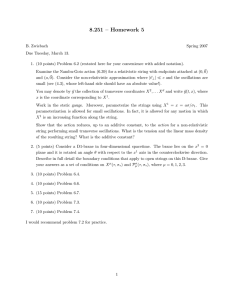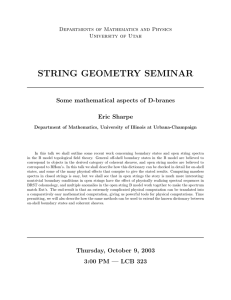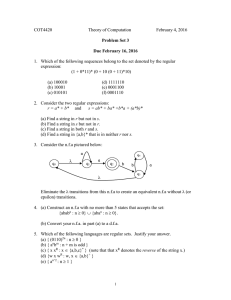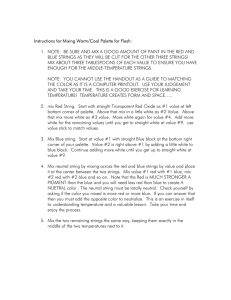-
advertisement
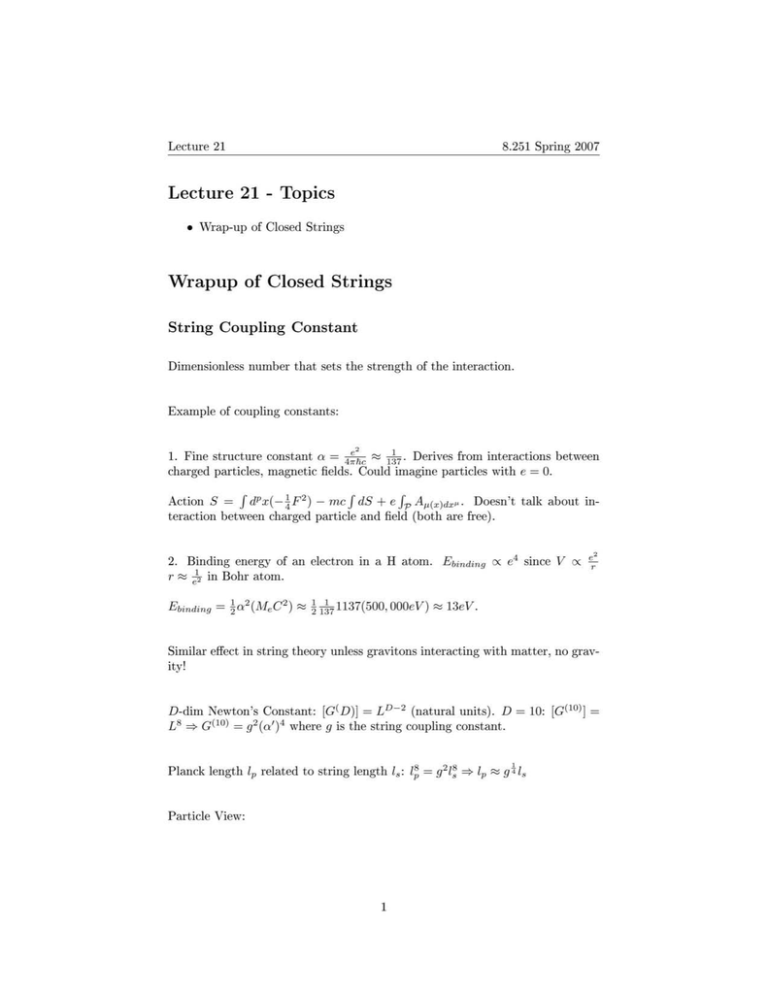
Lecture 21
8.251 Spring 2007
Lecture 21 - Topics
Wrap-up of Closed Strings
Wrapup of Closed Strings
String Coupling Constant
Dimensionless number that sets the strength of the interaction.
Example of coupling const ants:
& &.
1. Fine structure constant a =
o
Derives from interactions between
charged particles, magnetic fields. Could imagine particles with e = 0.
+
Action S = S dpx(- F ~-) mc S d S e A,(,)dxp. Doesn't talk about interaction between charged particle and field (both are free).
2. Binding energy of an electron in a H atom. Ebinding
0( e4 since V
r o $ in Bohr atom.
0(
<
Similar effect in string theory unless gravitons interacting with matter, no gravity!
D-dim Newton's Constant: [G(D)]= L ~ (natural
- ~ units). D = 10: [G(lO)]=
L~ + G('O) = g2(a')4
where g is the string coupling constant.
Planck length 1, related to string length 1,: 1:
Particle View:
= g21:
+ 1,
o gil,
Lecture 21
8.251 Spring 2007
String View:
Close string splits into 2 strings. Same coupling constant g'd string interactions.
really is
g for closed strings. +jfor open strings (too complicated for this class)
How do you fix g?
$(x) =dilation * a:'~i:+ 10) massless state. g = e d X ) ) .Field sets value of
coupling constant. So g changes with 4(x). Not a constant, but a dynamical
Lecture 21
8.251 Spring 2007
value. But usually work with constant field.
Superstrings
Everyone uses superstrings more than superstrings. Takes a long time to develop all background, so will present intuitively-reasonable results from QFT.
Pauli exclusion principle: multiple fermions cannot occupy the same state.
X"(r, a ) : Classical variables. Commute X1(r, a
The X's behave as boson fields in (7, a) space.
) (r',
~ a') =
x J(r',ar)X1(r,a ) .
In quantum theory, things don't quite commute. For operators A, B commutator [A,B] = A B - Be A. A and B commute if and only if [A,B] = 0.
Define: $: (r,a), $; (7, a). Classical, anticommuting variables
$g (7,a ) .
Let B1, B2 be classical anticommuting variables. Then B1B2 = -B2B1, Bl Bl =
-B1B1 + Bl Bl = 0. Same for all indices.
Set of anticomm. variables Bi:
B . B . - -B.B.
2 3 -
3
2
BiBi (not summed)
Example with matrices:
=0
Lecture 21
8.251 Spring 2007
7172
= -7,271
YlYl
# 0 # 722
Quantum operators f f 2
{ f l ,f 2 ) = f l f 2
+f2fl
Operators anticommute if and only if { f l , f 2 ) = 0.
Quantized a scalar field. Got particle state of
+
nl
(up1)
+
nk
particles
n2)...(aPk)+)"klfi)
(up2)
Electron Dirac Field
p: momentum, s: spin.
Creation operators have nonzero anticomm. operators with annihilation operators. All f +'s anticommute. This relates to the Pauli exclusion principle and
Fermi statistics.
+
Action: S = S ~ o s o n i c
S~ermionic
Lecture 21
8.251 Spring 2007
Action for LC coordinates. Tells you pretty much everything about dynamics
of LC variables.
What Dirac would have written for a fermion in 2D on the worldsheet, but we
can a fermion in spacetime.
Dirac equation usually written as $iyd$
Usually, Ad,A = ;&A2 but here the A's ($Ls) are anticommuting so A2 = 0.
Instead, Ad, A = d, (AA)
Varying a$:,
as,
=
1
7i-
-
(8, A) A. Ad, A + (8, A) A = 8, (AA) .
6$,'
J dTdo(ar:(a,+aa)$:+aa:(a-aa)$2)+- 27i-1 J
I a=r
2 ) a=O
Lecture 21
8.251 Spring 2007
Satisfies BC without too much violence.
1 w:(77 a*) = +w:(7' a*) I
Choose sign to be positive since action doesn't care, but then can't change sign
of field. We have two choices:
Continuous field over
[-T, T]
since $: (r,0) = $: (r,0)
9 fermion field is periodic if choose positive sign, antiperiodic if choose negative
sign.
Suppose choose periodic (Rammond sector)
Suppose choose antiperiodic (Neveu-Schawrz sector)


